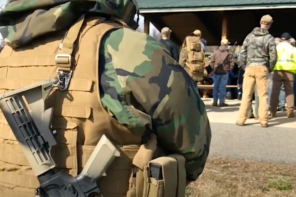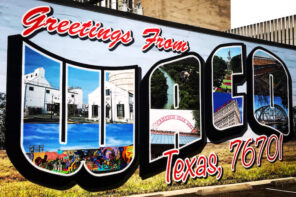Religion watchers across the country followed the story last month of the frantic search for a California “prayer group”—labeled a “cult” by the authorities—whose members, it was feared, might commit suicide and perhaps murder the children with them.
When the story broke, the CHP told the Los Angeles Times, that “it is believed… that [their] intentions are to commit mass suicide,” despite also reporting that “documents left behind by group members do not specifically mention suicide,” that “the missing people have no history of violence or harming themselves,” and that neighbors who knew the believers thought that such actions were unlikely. (Many noted how devoted the alleged “cult leader” is as a mother). Letters the group members left did mention going to see Jesus and made reference to “the end of the world.” However, as Anthea Butler wrote here on RD: “Chicas and her prayer group members are not aberrations; they are very much a phenomenon in many Pentecostal, Charismatic and non-denominational churches today.”
While the headlines indicated that family members, authorities (and the press) were in something of a panic, I followed the story on a discussion board of religious studies scholars who specialize in New Religious Movements (NRM), many of whom have expertise in incidences that have resulted in violence. In fact, Catherine Wessinger wrote an essay for RD describing the risks involved in the rush to apply the “cult” label to small or poorly understood religious groups.
Wessinger compared the stories of two Texas religious communities: Fundamentalist Latter-Day Saints (FLDS) at the Yearning for Zion (YFZ) ranch in El Dorado that was raided by authorities who took the community’s children into custody, and the Branch Davidians in Waco whose community was also raided, leading to a lengthy standoff and ultimately the death of 76 people—including more than 20 children. She wrote as the situation at YFZ ranch was still unfolding, and she explored the way in which the “cult” label has developed in regards to unfamiliar groups, and how the disparaging label often leads to inappropriate and dangerous responses.
The commonly understood meaning of the term “cult” was shaped by a now discredited “anti-cult movement” in the 1970s. This movement primarily consisted of evangelical Christians who, upset that their own adult children had left evangelicalism for new religious movements, were willing to use coercive techniques to “de-program them.” In contemporary use “cult” means little more (in terms of real content) than a religion that the one using the term doesn’t like. But the label effectively delegitimizes a religious group and makes what would otherwise be a clear violation of religious freedom, seem warranted and even necessary. When asked to comment on more recent developments, Wessinger told RD that “it appears from the coverage that ‘cult-like’ has become the new pejorative term.”
It’s especially easy to apply the “cult” label when the protection of children is invoked, though it can actually subject them to even greater dangers; tragically, the children at Waco died in the effort to protect them. And, as Wessinger originally argued, the experience of being ripped en masse from their families was surely damaging to the children at YFZ. In that case, remember, the 463 children who were taken into custody without due process were eventually returned when it was determined that there was no evidence to support removing them from their parents. Imagine a small town where over 450 children are removed from the custody of their parents on the basis of one (anonymous!) accusation of abuse; this result was made possible by virtue of the fact that they had effectively been delegitimized as a cult.
NRM scholar Stuart Wright, author of Patriots, Politics, and the Oklahoma City Bombing, also commented to RD about the recent developments in California:
The desire of the believers to retreat to the mountains to pray strikes me as an action firmly entrenched in the tradition of Christian asceticism. The rush to label the group as a ‘suicide cult’ probably says more about the mentality of law enforcement officials and sensational media than about the psychological state of this small prayer group.
Scholar Jayne Seminare Docherty, author of Learning Lessons from Waco: When the Parties Bring Their Gods to the Negotiating Table, uses the transcripts from the negotiations between the Branch Dravidians and law enforcement officials to show how the two were operating from fundamentally different—and incommensurate—frameworks or worldviews; and how that fact led to numerous misunderstandings that made the situation in Waco much, much worse. Docherty doesn’t argue that law enforcement officials were at fault in Waco, that they were incompetent or even that they were operating in bad faith, but rather that they had no training in understanding religious worldviews and did not draw on anyone who does. The result is that they sometimes play right into an apocalyptic script, making the situation worse rather than better.
According to Docherty, law enforcement protocols for engagement with non-traditional religions are drawn from hostage situations that are not comparable (a hostage taker in a bank, for example, usually has a specific goal in mind—a goal that can be negotiated—while religious groups are motivated by other concerns). Protocols are also developed from “conflict resolution models” that assume a shared frame of reference between both sides, explicitly rejecting issues not amenable to “rational negotiation.”
Other strategies require law enforcement officers to make psychological assessments without adequate training, and in situations that actual psychologists and psychiatrists would not (which, in the case of Waco, resulted in a variety of “diagnoses,” many of which were contradictory and irreconcilable). Worse yet, the mass suicide in the 1970s in Jonestown is often used as a model when it might be more effective to, say, choose an example with a positive outcome on which to build a strategy.
Though Docherty was in Myanmar during the hunt for the prayer group, others who are familiar with her scholarship and who have done similar work did comment both on the discussion board and in response to queries made by RD. They continued to express concern at the potential for missteps leading to tragedy; advocating caution, evaluating each group on its own terms, and with consultation with people who are legitimate experts on New Religious Movements, rather than self-styled cult experts. Again, Stuart Wright told RD, “It would be constructive for law enforcement agencies to have access to social science experts on religion (not “cult” experts), particularly those who have studied apocalyptic or millenarian groups, when confronted with incidents like the Palmdale case.”
While the prayer group has been located (the adults, according to reports, praying in a park while the children played on the playground) there has been little reflection on what it means that the group was so readily labeled “a cult” and assumed to be suicidal.
Might things have developed differently if they had been praying in a building instead of in a park where authorities could immediately see that the children were safe? Did the assumption that they were suicidal lead to the assumption that they had weapons with which to accomplish their goals? There’s a vast difference between “we need to go look for a group of missing Christians because their family members are concerned,” and “a suicidal cult leader and her followers have disappeared with children.” The second framing legitimates very different responses (even violent ones) on the part of authorities.
NRM scholars advocate a more careful approach in which authorities seek the help of those most fluent in the language and worldview of such religious groups. They offer their expertise to the media and law enforcement, they testify in hearings, they speak out at every opportunity. Yet it still seems that both the media and the authorities are reluctant to listen.
Wessinger stressed that “whether or not there was genuine cause for concern depends on the nature of the letters and items that were left behind with family members. It is possible that these items did seem to indicate that the group expected a quick transition to heaven.” And, said Wright, we do know from reports that:
As far as I can tell from the documents left behind, they do not mention mass suicide, as authorities feared, but refer to “going to heaven” and “end of the world.” These are very common phrases and images found among Christian fundamentalist and evangelical communities and culture.
The “take-away” from those most knowledgeable about such situations, as Wessinger told RD, is that “each group needs to be evaluated on its own terms without the imposition of preconceptions.” And, added Wright, “scholars can act as ‘cultural translators’ and perhaps allay runaway fears of officials, relatives and the media about panicked claims of mass suicide.”
Thankfully, the assumption that the group was a suicide cult didn’t bring about a disaster, but what was revealed is that past lessons in averting dangerous confrontations have yet to be learned.




